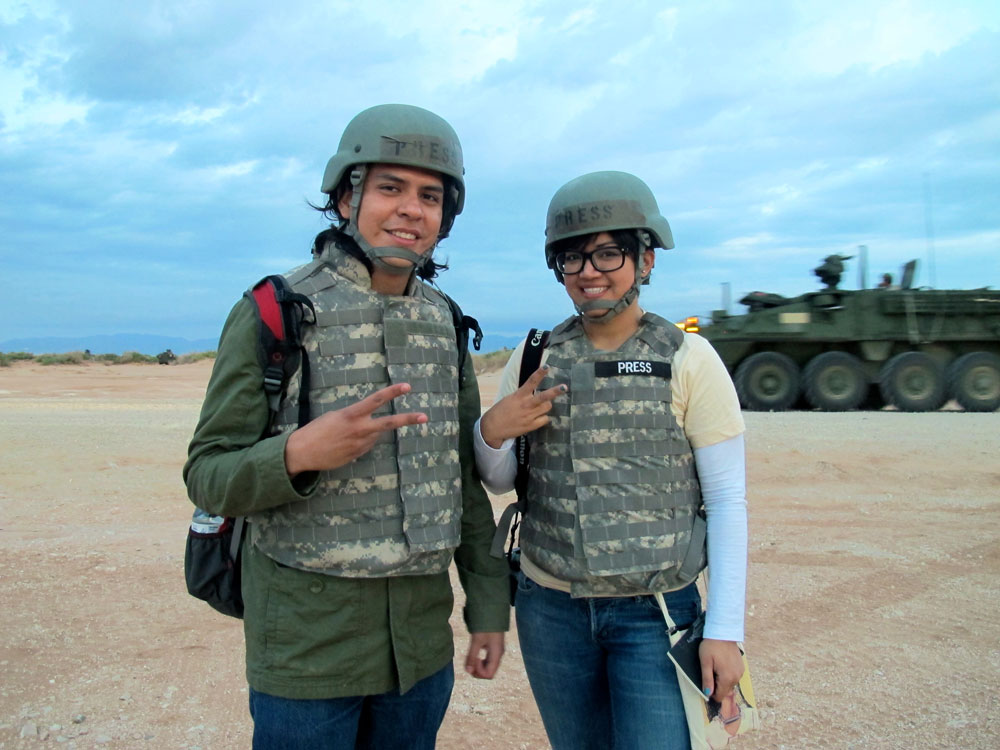It’s been five years since my wife Danya and I first walked into the Cotton Memorial building for our introduction to journalism class at the University of Texas at El Paso. This is where we met our mentors David Smith Soto, Zita Arocha, and Lourdes Cueva Chacon. And where we learned the countless lessons we referenced every day at our internships and now at our jobs working for a daily newspaper.

While journalism students at UT El Paso, UTEP journalism students, Kristian and Danya Hernandez, participated in the “Iron Focus” tactical military training exercise at Fort Bliss. Photo by Alejandra Matos, Borderzine.com
I was a creative writer at heart and felt comfortable with my storytelling abilities. Danya was an artistic photographer and felt comfortable telling visual stories. At UTEP we were some of the first students to enroll as multimedia major journalism majors.
Related story: Borderzine redesign reaches out to Border Life readers across all platforms
This curriculum taught us what a modern journalist should do and helped us expand our talents while learning the skills to compete in a time when all newsrooms are downsizing. Today both of us are able to choose the appropriate medium to tell a news story from different angles.
Danya and I graduated in 2013 and after four internships that took us all over the country we were hired at The Monitor in McAllen, Texas, three months ago. I am the courts and cops reporter and Danya is the education reporter. The Monitor is currently going through several changes including a web first initiative and a push for multimedia stories. This pushed some journalists out of their comfort zone, but we are well versed in online and multimedia stories thanks to Borderzine and the hands on journalism training we received.
I will always remember the day professor Soto called us into his office and asked us what internships we were applying for. I was a full time sales manager at a construction company and had worked my way up the ladder for six years. Danya was also in management and was months away from her five year anniversary at an insurance company.
We were working full time, paying for school and sharing the responsibility of bills and a mortgage. We explained to Soto that we could not afford to lose our jobs for an internship. He quietly listened as we laid it all out for him and simply said, “I don’t want to hear any excuses.” That’s all we needed to hear.
In one year we saved $10,000 and were off to Washington D.C. where we both landed paid internships through the Scripps Howard Foundation. Our professors had pushed us out of our comfort zones and we were able to hit the ground running, with a camera around our neck and notebook in hand.
That first internship was more than worth our efforts, and after that Danya and I were lucky to find more opportunities to intern in the same cities, allowing us to share these experiences. At one point we were even chosen to participate in the New York Times Student Journalism Institute together, without the organizers knowing we were married.
Many UTEP students are making similar sacrifices for internships. It is this real world experience and the fact that we don’t take opportunities for granted that defines us as Miners.
I’m glad we didn’t take Borderzine’s training lightly, because it prepared us to compete with interns from the best Ivy League schools across the country. Although we were intimidated at first, we quickly realized that we had unique skills to offer.
Today we are proud of our Borderzine family that continues to grow semester after semester thanks to the efforts of our wonderful mentors. We hope many young Latino journalists find their way into that classroom in Cotton Memorial where they can gather the tools to later find opportunities in newsrooms all over the nation.
Related:
See Kristian Hernandez’s work on Borderzine here
See Danya Hernandez’s work on Borderzine here


